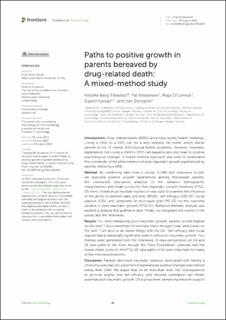| dc.contributor.author | Titlestad, Kristine Berg | |
| dc.contributor.author | Kristensen, Pål | |
| dc.contributor.author | O'Connor, Maja | |
| dc.contributor.author | Hystad, Sigurd William | |
| dc.contributor.author | Dyregrov, Kari | |
| dc.date.accessioned | 2022-11-07T12:52:34Z | |
| dc.date.available | 2022-11-07T12:52:34Z | |
| dc.date.created | 2022-08-27T19:39:56Z | |
| dc.date.issued | 2022 | |
| dc.identifier.issn | 1664-1078 | |
| dc.identifier.uri | https://hdl.handle.net/11250/3030445 | |
| dc.description.abstract | Introduction: Drug-related deaths (DRDs) are a major public health challenge. Losing a child to a DRD can be a very stressful life event, which places parents at risk of mental and physical health problems. However, traumatic experiences like losing a child to DRD can paradoxically also lead to positive psychological changes. A mixed-method approach was used to understand the complexity of the phenomenon of post-traumatic growth experienced by parents following a DRD.
Method: By combining data from a survey (n = 89) and interviews (n = 14), we explored positive growth experiences among Norwegian parents. We conducted descriptive analyses of the sample’s demographic characteristics and mean scores for Post-traumatic Growth Inventory (PTGI-SF) items. Hierarchical multiple regression was used to examine the influence of the ability to perform daily activities (WSAS), self-efficacy (GSE-SF), social support (CSS), and symptoms of prolonged grief (PG-13) on the outcome variable of post-traumatic growth (PTGI-SF). Reflexive thematic analysis was applied to analyze the qualitative data. Finally, we integrated the results of the survey and the interviews.
Results: For items measuring post-traumatic growth, parents scored highest on the item “I discovered that I’m stronger than I thought I was” and lowest on the item “I am able to do better things with my life.” Self-efficacy and social support had a statistically significant relation with post-traumatic growth. Two themes were generated from the interviews: (I) new perspectives on life and (II) new paths in life. Even though the “New Possibilities” subscale had the lowest mean score for the PTGI-SF, new paths in life were important for many of the interviewed parents.
Discussion: Parents described traumatic stressors associated with having a child who uses narcotics and hence experienced positive changes even before losing their child. We argue that on an individual level, the consequences of spillover stigma, low self-efficacy, and intrusive rumination can hinder potential post-traumatic growth. On a group level, enhancing network support may increase post-traumatic growth experiences. Hence, parents who have experienced a DRD can benefit from help to activate their social networks and strengthen their self-efficacy. | en_US |
| dc.language.iso | eng | en_US |
| dc.publisher | Frontiers | en_US |
| dc.rights | Navngivelse 4.0 Internasjonal | * |
| dc.rights.uri | http://creativecommons.org/licenses/by/4.0/deed.no | * |
| dc.title | Paths to positive growth in parents bereaved by drug-related death: A mixed-method study | en_US |
| dc.type | Journal article | en_US |
| dc.type | Peer reviewed | en_US |
| dc.description.version | publishedVersion | en_US |
| dc.rights.holder | Copyright 2022 The Author(s) | en_US |
| dc.source.articlenumber | 982667 | en_US |
| cristin.ispublished | true | |
| cristin.fulltext | original | |
| cristin.qualitycode | 1 | |
| dc.identifier.doi | 10.3389/fpsyg.2022.982667 | |
| dc.identifier.cristin | 2046459 | |
| dc.source.journal | Frontiers in Psychology | en_US |
| dc.relation.project | Norges forskningsråd: 300732 | en_US |
| dc.identifier.citation | Frontiers in Psychology. 2022, 13, 982667. | en_US |
| dc.source.volume | 13 | en_US |

